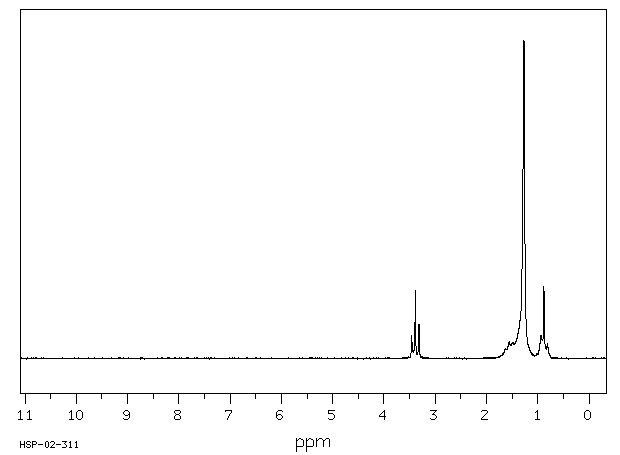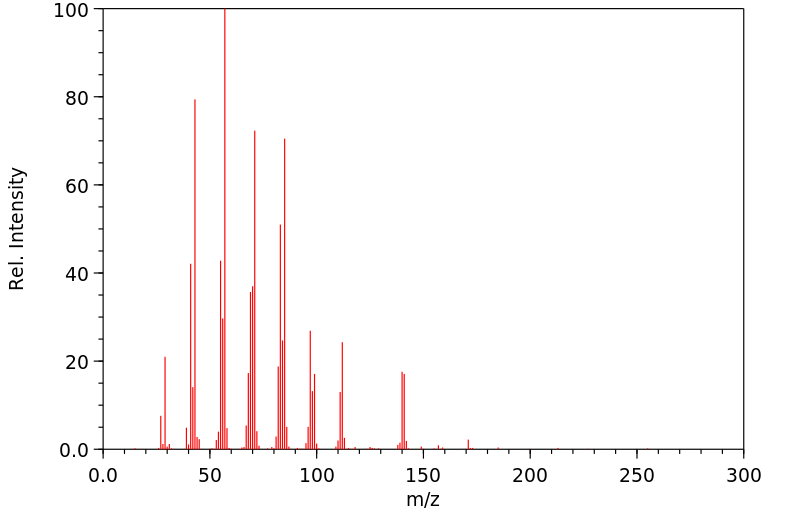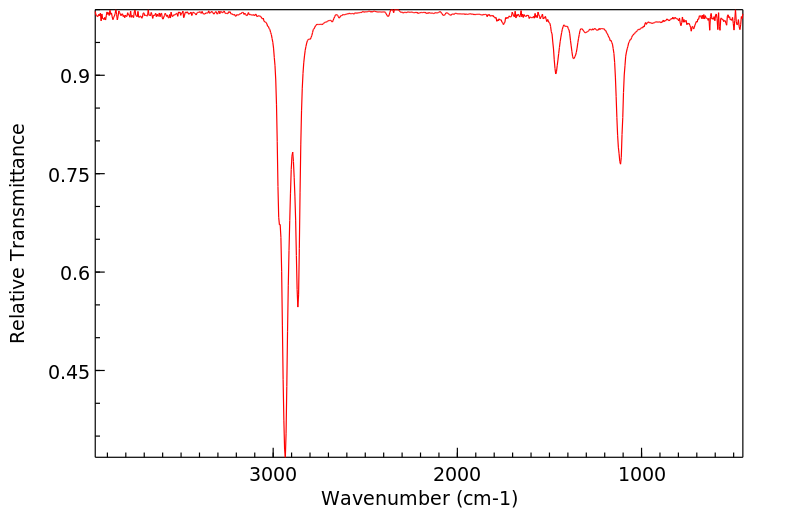癸醚 | 2456-28-2
物质功能分类
中文名称
癸醚
中文别名
正癸醚
英文名称
decyl ether
英文别名
didecyl ether;di-n-decyl ether;1-decoxydecane
CAS
2456-28-2
化学式
C20H42O
mdl
——
分子量
298.553
InChiKey
LTSWUFKUZPPYEG-UHFFFAOYSA-N
BEILSTEIN
——
EINECS
——
-
物化性质
-
计算性质
-
ADMET
-
安全信息
-
SDS
-
制备方法与用途
-
上下游信息
-
文献信息
-
表征谱图
-
同类化合物
-
相关功能分类
-
相关结构分类
物化性质
-
熔点:-16°C
-
沸点:196°C/15mm
-
密度:0,82 g/cm3
-
闪点:196°C/15mm
-
溶解度:Insoluble in water, soluble in alcohol, miscible with oils.
-
LogP:9.192 (est)
-
稳定性/保质期:
在常温常压下保持稳定,应避免与氧化物接触。
计算性质
-
辛醇/水分配系数(LogP):9.1
-
重原子数:21
-
可旋转键数:18
-
环数:0.0
-
sp3杂化的碳原子比例:1.0
-
拓扑面积:9.2
-
氢给体数:0
-
氢受体数:1
安全信息
-
TSCA:Yes
-
安全说明:S24/25
-
海关编码:2909199090
-
储存条件:请将容器密封后,放入一个紧密封装的容器中,并存放在阴凉、干燥的地方。
SDS
癸醚 修改号码:5
模块 1. 化学品
产品名称: Decyl Ether
修改号码: 5
模块 2. 危险性概述
GHS分类
物理性危害 未分类
健康危害 未分类
环境危害 未分类
GHS标签元素
图标或危害标志 无
信号词 无信号词
危险描述 无
防范说明 无
模块 3. 成分/组成信息
单一物质/混和物 单一物质
化学名(中文名): 癸醚
百分比: >95.0%(GC)
CAS编码: 2456-28-2
俗名: Didecyl Ether
分子式: C20H42O
模块 4. 急救措施
吸入: 将受害者移到新鲜空气处,保持呼吸通畅,休息。若感不适请求医/就诊。
皮肤接触: 立即去除/脱掉所有被污染的衣物。用水清洗皮肤/淋浴。
若皮肤刺激或发生皮疹:求医/就诊。
眼睛接触: 用水小心清洗几分钟。如果方便,易操作,摘除隐形眼镜。继续清洗。
如果眼睛刺激:求医/就诊。
食入: 若感不适,求医/就诊。漱口。
紧急救助者的防护: 救援者需要穿戴个人防护用品,比如橡胶手套和气密性护目镜。
模块 5. 消防措施
合适的灭火剂: 干粉,泡沫,二氧化碳
不适用的灭火剂: 水(有可能扩大灾情。)
癸醚 修改号码:5
模块 5. 消防措施
特定方法: 从上风处灭火,根据周围环境选择合适的灭火方法。
非相关人员应该撤离至安全地方。
周围一旦着火:如果安全,移去可移动容器。
消防员的特殊防护用具: 灭火时,一定要穿戴个人防护用品。
模块 6. 泄漏应急处理
个人防护措施,防护用具, 使用个人防护用品。远离溢出物/泄露处并处在上风处。确保足够通风。
紧急措施: 泄露区应该用安全带等圈起来,控制非相关人员进入。
环保措施: 防止进入下水道。
控制和清洗的方法和材料: 用合适的吸收剂(如:旧布,干砂,土,锯屑)吸收泄漏物。一旦大量泄漏,筑堤控
制。附着物或收集物应该立即根据合适的法律法规废弃处置。
模块 7. 操作处置与储存
处理
技术措施: 在通风良好处进行处理。穿戴合适的防护用具。防止烟雾产生。处理后彻底清洗双手
和脸。
注意事项: 如果蒸气或浮质产生,使用通风、局部排气。
操作处置注意事项: 避免接触皮肤、眼睛和衣物。
贮存
储存条件: 保持容器密闭。存放于凉爽、阴暗处。
远离不相容的材料比如氧化剂存放。
包装材料: 依据法律。
模块 8. 接触控制和个体防护
工程控制: 尽可能安装封闭体系或局部排风系统,操作人员切勿直接接触。同时安装淋浴器和洗
眼器。
个人防护用品
呼吸系统防护: 防毒面具。依据当地和政府法规。
手部防护: 防护手套。
眼睛防护: 安全防护镜。如果情况需要,佩戴面具。
皮肤和身体防护: 防护服。如果情况需要,穿戴防护靴。
模块 9. 理化特性
液体
外形(20°C):
外观: 透明
颜色: 无色-极淡的黄色
气味: 无资料
pH: 无数据资料
熔点: 无资料
沸点/沸程 196 °C/2.1kPa
闪点: 无资料
爆炸特性
爆炸下限: 无资料
爆炸上限: 无资料
密度: 0.82
溶解度:
[水] 无资料
[其他溶剂] 无资料
癸醚 修改号码:5
模块 10. 稳定性和反应性
化学稳定性: 一般情况下稳定。
危险反应的可能性: 未报道特殊反应性。
须避免接触的物质 氧化剂
危险的分解产物: 一氧化碳, 二氧化碳
模块 11. 毒理学信息
急性毒性: 无资料
对皮肤腐蚀或刺激: 无资料
对眼睛严重损害或刺激: 无资料
生殖细胞变异原性: 无资料
致癌性:
IARC = 无资料
NTP = 无资料
生殖毒性: 无资料
模块 12. 生态学信息
生态毒性:
鱼类: 无资料
甲壳类: 无资料
藻类: 无资料
残留性 / 降解性: 无资料
潜在生物累积 (BCF): 无资料
土壤中移动性
log水分配系数: 无资料
土壤吸收系数 (Koc): 无资料
亨利定律 无资料
constaNT(PaM3/mol):
模块 13. 废弃处置
如果可能,回收处理。请咨询当地管理部门。建议在装有后燃和洗涤装置的化学焚烧炉中焚烧。废弃处置时请遵守
国家、地区和当地的所有法规。
模块 14. 运输信息
联合国分类: 与联合国分类标准不一致
UN编号: 未列明
模块 15. 法规信息
《危险化学品安全管理条例》(2002年1月26日国务院发布,2011年2月16日修订): 针对危险化学品的安全使用、
生产、储存、运输、装卸等方面均作了相应的规定。
癸醚 修改号码:5
模块16 - 其他信息
N/A
模块 1. 化学品
产品名称: Decyl Ether
修改号码: 5
模块 2. 危险性概述
GHS分类
物理性危害 未分类
健康危害 未分类
环境危害 未分类
GHS标签元素
图标或危害标志 无
信号词 无信号词
危险描述 无
防范说明 无
模块 3. 成分/组成信息
单一物质/混和物 单一物质
化学名(中文名): 癸醚
百分比: >95.0%(GC)
CAS编码: 2456-28-2
俗名: Didecyl Ether
分子式: C20H42O
模块 4. 急救措施
吸入: 将受害者移到新鲜空气处,保持呼吸通畅,休息。若感不适请求医/就诊。
皮肤接触: 立即去除/脱掉所有被污染的衣物。用水清洗皮肤/淋浴。
若皮肤刺激或发生皮疹:求医/就诊。
眼睛接触: 用水小心清洗几分钟。如果方便,易操作,摘除隐形眼镜。继续清洗。
如果眼睛刺激:求医/就诊。
食入: 若感不适,求医/就诊。漱口。
紧急救助者的防护: 救援者需要穿戴个人防护用品,比如橡胶手套和气密性护目镜。
模块 5. 消防措施
合适的灭火剂: 干粉,泡沫,二氧化碳
不适用的灭火剂: 水(有可能扩大灾情。)
癸醚 修改号码:5
模块 5. 消防措施
特定方法: 从上风处灭火,根据周围环境选择合适的灭火方法。
非相关人员应该撤离至安全地方。
周围一旦着火:如果安全,移去可移动容器。
消防员的特殊防护用具: 灭火时,一定要穿戴个人防护用品。
模块 6. 泄漏应急处理
个人防护措施,防护用具, 使用个人防护用品。远离溢出物/泄露处并处在上风处。确保足够通风。
紧急措施: 泄露区应该用安全带等圈起来,控制非相关人员进入。
环保措施: 防止进入下水道。
控制和清洗的方法和材料: 用合适的吸收剂(如:旧布,干砂,土,锯屑)吸收泄漏物。一旦大量泄漏,筑堤控
制。附着物或收集物应该立即根据合适的法律法规废弃处置。
模块 7. 操作处置与储存
处理
技术措施: 在通风良好处进行处理。穿戴合适的防护用具。防止烟雾产生。处理后彻底清洗双手
和脸。
注意事项: 如果蒸气或浮质产生,使用通风、局部排气。
操作处置注意事项: 避免接触皮肤、眼睛和衣物。
贮存
储存条件: 保持容器密闭。存放于凉爽、阴暗处。
远离不相容的材料比如氧化剂存放。
包装材料: 依据法律。
模块 8. 接触控制和个体防护
工程控制: 尽可能安装封闭体系或局部排风系统,操作人员切勿直接接触。同时安装淋浴器和洗
眼器。
个人防护用品
呼吸系统防护: 防毒面具。依据当地和政府法规。
手部防护: 防护手套。
眼睛防护: 安全防护镜。如果情况需要,佩戴面具。
皮肤和身体防护: 防护服。如果情况需要,穿戴防护靴。
模块 9. 理化特性
液体
外形(20°C):
外观: 透明
颜色: 无色-极淡的黄色
气味: 无资料
pH: 无数据资料
熔点: 无资料
沸点/沸程 196 °C/2.1kPa
闪点: 无资料
爆炸特性
爆炸下限: 无资料
爆炸上限: 无资料
密度: 0.82
溶解度:
[水] 无资料
[其他溶剂] 无资料
癸醚 修改号码:5
模块 10. 稳定性和反应性
化学稳定性: 一般情况下稳定。
危险反应的可能性: 未报道特殊反应性。
须避免接触的物质 氧化剂
危险的分解产物: 一氧化碳, 二氧化碳
模块 11. 毒理学信息
急性毒性: 无资料
对皮肤腐蚀或刺激: 无资料
对眼睛严重损害或刺激: 无资料
生殖细胞变异原性: 无资料
致癌性:
IARC = 无资料
NTP = 无资料
生殖毒性: 无资料
模块 12. 生态学信息
生态毒性:
鱼类: 无资料
甲壳类: 无资料
藻类: 无资料
残留性 / 降解性: 无资料
潜在生物累积 (BCF): 无资料
土壤中移动性
log水分配系数: 无资料
土壤吸收系数 (Koc): 无资料
亨利定律 无资料
constaNT(PaM3/mol):
模块 13. 废弃处置
如果可能,回收处理。请咨询当地管理部门。建议在装有后燃和洗涤装置的化学焚烧炉中焚烧。废弃处置时请遵守
国家、地区和当地的所有法规。
模块 14. 运输信息
联合国分类: 与联合国分类标准不一致
UN编号: 未列明
模块 15. 法规信息
《危险化学品安全管理条例》(2002年1月26日国务院发布,2011年2月16日修订): 针对危险化学品的安全使用、
生产、储存、运输、装卸等方面均作了相应的规定。
癸醚 修改号码:5
模块16 - 其他信息
N/A
上下游信息
反应信息
-
作为反应物:参考文献:名称:A novel reduction of alcohols and ethers with a HSiEt3catalytic B(C6F5)3 system摘要:The primary alcohols 1a-d and ethers 4a-b were effectively reduced into the corresponding hydrocarbons 2 by HSiEt3 in the presence of catalytic amounts of B(C6F5)(3). The secondary alkyl ethers 4g,h underwent cleavage and/or reduction under similar reaction conditions to produce either the silyl ether 3k or the corresponding alcohol 5b upon subsequent deprotection with TBAF. The secondary alcohols (1g,h) and tertiary alcohol 1i, as well as tertiary alkyl ether 4i, did not react with the HSiEt3/(B(C6F5)(3) reducing reagent at all. The following relative reactivity order of substrates was found: primary>>secondary>tertiary. The methyl aryl ethers 4c-e and alkyl aryl ether 4f were smoothly deprotected to give the corresponding silyl ethers 3b,h-j in nearly quantitative isolated yields. (C) 1999 Elsevier Science Ltd. All rights reserved.DOI:10.1016/s0040-4039(99)01757-8
-
作为产物:参考文献:名称:锑(v)阳离子,用于将醛选择性催化转化为对称醚,α,β-不饱和醛和1,3,5-三恶烷†摘要:通过用二溴三苯基苯乙烯硼烷处理1-lithio-8-diphenylphosphinonaphthalene,然后用AgOTf提取卤化物,以优异的收率制备了1-triphenylphosphinonaphthyl -8-triphenylstibonium triflate([ 2 ] [OTf])。发现该锑(V)阳离子对氧气和水稳定,并表现出出众的路易斯酸度。[ 2 ] [OTf]的路易斯酸度是在Et 3 SiH作为还原剂的条件下,在温和的条件下,以良好至极佳的收率,将多种醛催化还原偶联为L型对称醚。此外,发现[ 2 ] [OTf]选择性催化Aldol缩合反应,得到α-β不饱和醛(M)当使用具有2个α-氢原子的醛时。最后,[ 2 ] [OTf]催化脂肪族和芳香族醛的环三聚反应,以高收率和高选择性提供了工业上有用的1,3,5三恶烷(N)。这种膦-sti基序是同类催化系统中的第一种,它能够以DOI:10.1039/c6dt02121b
文献信息
-
Use of pseudopterosins for promoting wound healing申请人:OsteoArthritis Sciences, Incorporated公开号:US05597808A1公开(公告)日:1997-01-28Methods of promoting wound healing and the growth and proliferation of keratinocytes, fibroblasts and endothelial cells are disclosed. These methods comprise contacting a wound with an effective wound healing amount of a composition comprising a pseudopterosin or pseudopterosin derivative.促进伤口愈合以及角质细胞、成纤维细胞和内皮细胞的生长和增殖的方法被披露。这些方法包括将含有伪海扇素或伪海扇素衍生物的组合物的有效伤口愈合量与伤口接触。
-
Ether derivatives of pseudopterosin申请人:The Regents of the University of California公开号:US05624911A1公开(公告)日:1997-04-29Methods for treating mammals to reduce pain and/or reduce inflammation are described based on administering to the mammals synthetic ether derivatives of pseudopterosin having the formula: ##STR1## wherein A is an alkyl, aryl or amide group having from 2 to 20 carbon atoms, R.sub.1, R.sub.2 and R.sub.3 are hydrogen or an acyl residue (--COR) having from 1 to 6 carbon atoms, R.sub.4 is hydrogen or --CH.sub.2 OH and R.sub.5 is a hydrocarbon having from 1 to 10 carbon atoms. Also disclosed are synthetic compositions having the above general formula which are useful in the described method.描述了治疗哺乳动物以减轻疼痛和/或减少炎症的方法,该方法基于向哺乳动物施用具有以下式子的伪海扇素的合成醚衍生物:##STR1## 其中A是具有2至20个碳原子的烷基、芳基或酰胺基团,R.sub.1、R.sub.2和R.sub.3是氢或具有1至6个碳原子的酰基残基(--COR),R.sub.4是氢或--CH.sub.2 OH,R.sub.5是具有1至10个碳原子的碳氢化合物。还公开了具有上述一般式的合成组合物,这些组合物在所述方法中是有用的。
-
Conversion of Alkyl Halides into Alcohols via Formyloxylation Reaction with DMF Catalyzed by Silver Salts作者:Antonio Abad、Consuelo Agulló、Ana C. Cuñat、Ismael NavarroDOI:10.1055/s-2005-918453日期:——transformation of alkyl halides into alcohols via a two-step process based on the reaction with DMF catalyzed by Ag(I) salts followed by acid or basic hydrolysis of the intermediate formate ester has been evaluated. The results show that a large variety of primary and some secondary alkyl halides can be transformed efficiently into the corresponding alcohols, making this alkyl halide to alcohol interconversion
-
Process for producing ether compound申请人:Kao Corporation公开号:US05914430A1公开(公告)日:1999-06-22Ether compounds, which are useful as solvents, cosmetics, detergents, lubricants, emulsifiers and so on, are produced by reacting (a) a hydroxy compound with a carbonyl compound of (b) a carbonyl compound under hydrogen atmosphere in the presence of a catalyst with ease and at a low cost. The reaction is carried out while removing out produced water by using a dehydrating agent during the reaction; by distilling off the water by azeotropic dehydration and the like; or by blowing gases such as hydrogen gas to flow through the reaction system.
-
Hydrogen bonding Part 44 Thermodynamics of complexation of 3,5-dichlorophenol with ketones and ethers in cyclohexane: the Badger–Bauer relationship作者:Michael H. Abraham、David V. Prior、Ronald A. Schulz、Jeffrey J. Morris、Peter J. TaylorDOI:10.1039/a708362i日期:——Equilibrium constants for 1:1 hydrogen bond complexation between 3,5-dichlorophenol (DCP) and 17 ketones and 12 ethers in cyclohexane solution have been obtained by an FTIR method that takes into account both dimerization of the acid and formation of 2:1 complexes. Enthalpies of complexation for the same ketones and ethers have been determined by a calorimetric method, leading to values of log K, ÎG°, ÎH° and ÎS° for 1:1 complexation in the 29 systems, as well as log K2 for the 2:1 complexation between 2 mol of acid and 1 mol of base. For the ketone systems there is very little variation in the three thermodynamic parameters with alkyl substitution, but for the ethers there are systematic variations depending on the alkyl substituent or if the ethers are cyclic.Values of the OH stretching frequency in the DCP complexes with the ketones and ethers in cyclohexane have been obtained. The band shapes for the DCPâketone complexes are very asymmetric, possibly due to the presence of stereoisomeric complexes, but the νOH band for DCPâether complexes is symmetric and very suitable for the evaluation of any relationship between νOH and ÎH°. It is found that for the complexation of DCP with the 12 aliphatic ethers in cyclohexane, there is almost no connection between the calorimetrically determined ÎH° values and values of ÎνOH.在环己烷溶液中,通过FTIR方法获得了3,5-二氯苯酚(DCP)与17种酮及12种醚之间1:1氢键复合的平衡常数,该方法考虑了酸的二聚化和2:1复合物的形成。对于相同的酮和醚,通过热量测定法确定了复合的焓变,得出了29个体系中1:1复合的log K、ΔG°、ΔH°和ΔS°值,以及2:1复合(2摩尔酸与1摩尔碱之间)的log K2值。对于酮体系,三种热力学参数随烷基取代几乎没有变化,但对醚而言,参数则随着烷基取代基的不同或醚的环状与否而呈现系统性的变化。已获得环己烷中DCP与酮和醚复合物的OH伸缩频率值。DCP–酮复合物的谱带形状非常不对称,可能是由于立体异构复合物的存在,而DCP–醚复合物的νOH谱带则对称,十分适合评估νOH与ΔH°之间的关系。研究发现,在环己烷中,DCP与12种脂肪醚的复合几乎没有热量测定的ΔH°值与ΔνOH值之间的关联。
表征谱图
-
氢谱1HNMR
-
质谱MS
-
碳谱13CNMR
-
红外IR
-
拉曼Raman
-
峰位数据
-
峰位匹配
-
表征信息
同类化合物
(反式)-4-壬烯醛
(s)-2,3-二羟基丙酸甲酯
([1-(甲氧基甲基)-1H-1,2,4-三唑-5-基](苯基)甲酮)
(Z)-4-辛烯醛
(S)-氨基甲酸酯β-D-O-葡糖醛酸
(S)-3-(((2,2-二氟-1-羟基-7-(甲基磺酰基)-2,3-二氢-1H-茚满-4-基)氧基)-5-氟苄腈
(R)-氨基甲酸酯β-D-O-葡糖醛酸
(5,5-二甲基-2-(哌啶-2-基)环己烷-1,3-二酮)
(2,5-二氟苯基)-4-哌啶基-甲酮
龙胆苦苷
龙胆二糖甲乙酮氰醇(P)
龙胆二糖丙酮氰醇(P)
龙胆三糖
龙涎酮
齐罗硅酮
齐留通beta-D-葡糖苷酸
鼠李糖
黑芥子苷单钾盐
黑海棉酸钠盐
黑木金合欢素
黑曲霉三糖
黑介子苷
黄尿酸8-O-葡糖苷
麻西那霉素II
麦迪霉素
麦芽糖脎
麦芽糖基海藻糖
麦芽糖1-磷酸酯
麦芽糖
麦芽四糖醇
麦芽四糖
麦芽十糖
麦芽六糖
麦芽五糖水合物
麦芽五糖
麦芽五糖
麦芽五糖
麦芽三糖醇
麦芽三糖
麦芽三糖
麦芽三塘水合
麦芽七糖水合物
麦芽七糖
麦法朵
麦可酚酸-酰基-Β-D-葡糖苷酸
麦利查咪
麝香酮
鹤草酚
鸢尾酚酮 3-C-beta-D-吡喃葡萄糖苷
鸡矢藤苷










